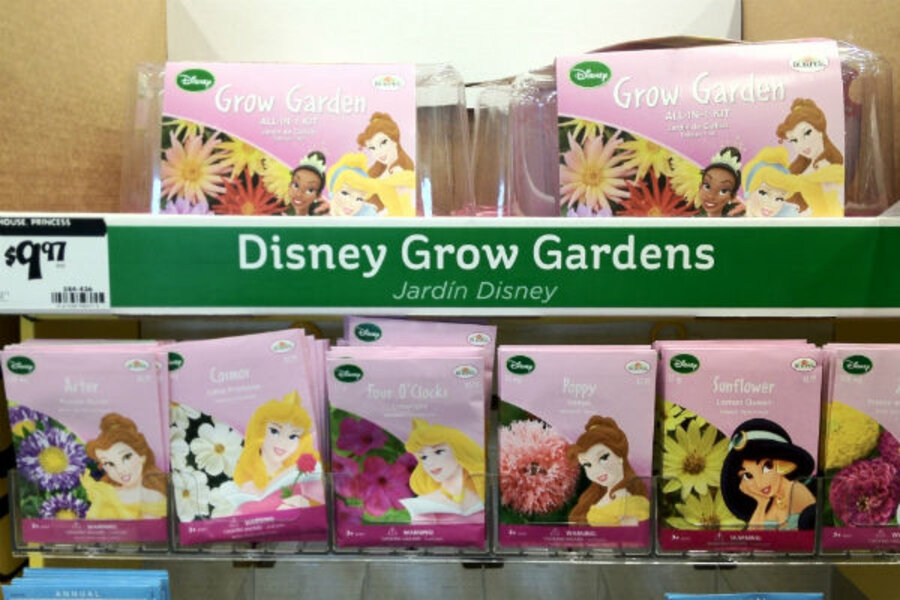Disney Princess flowers: coming soon to a garden near you
Loading...
Imagine this scenario:
Four-year-old Madison is obsessed with princesses. She wants to eat, sleep, breathe nothing but Disney Princess products, and it’s becoming a point of contention in her household. Her parents are tired of all the little battles over what she will wear, watch, and play with.
Madison’s mom blames herself for this situation. She loved princesses when she was a little girl, so she’s been buying princess products for Madison since Madison was an infant. She thinks sadly, “I can’t believe I did this to my daughter.”
But summer is coming, and Madison’s parents look forward to spending time outdoors. They think involving her in a little gardening might encourage her to branch out a bit–develop new interests.
It’s time to start planting, so they plan a visit to their local garden shop. Building up Madison’s enthusiasm, they tell her, “You can choose any seeds you want to plant! We’ll help you take care of them and you can see how they grow.” She is excited. “Maybe I’ll plant some carrots,” she says.
But then we reached the display. Burpee, capitalizing on the popularity of Disney Princesses, has licensed the names and likenesses of Belle, Sleeping Beauty, Jasmine, and Cinderella to adorn their flowers’ seed packets.
After seeing the Disney flower packets, Madison wants Princess flowers and nothing else. Her discouraged parents remind her that she wanted carrots, but Madison insists. “I want a princess garden, Mommy! Daddy, don’t say no.”
Looking around the corner, her parents see that Burpee does offer Disney-branded vegetables – but they’re not princess-themed. The logic must be that princesses are meant to be gazed upon; they are delicate beauties; so they only adorn the packages of flowers, which share these qualities. The veggie seed packs go to Mickey and friends.
Madison’s parents never dreamed Disney would co-opt their gardening experience, and they did tell her she could choose any packets she wants….so despite her parents’ reluctance, the princess flowers win.
For this “privilege” of purchasing seeds that have Disney characters on their packaging, her parents will spend $1.99 a package, instead of the $1.00 to $1.19 Burpee charges for otherwise identical packages of seeds with no licensed characters on them — making the outing twice as expensive as it should have been.
Oh, and don’t forget the princess-themed plant labels, which cost $2.97 for a package of six–way more than the plain ones, which cost $1.99 for a package of twenty. Yikes.
(Hey, at least Tiana’s included on the packaging.)
Now, I don’t mean to knock Burpee for licensing Disney characters on their products. Gardening isn’t very exciting for modern kids; it’s slow-moving. Maybe Disney-branded seeds are actually a great way get them involved in a healthy, satisfying activity that requires more patience and work than they’re used to. (And as far as the princess-flower / animal-food divide goes, maybe Burpee’s team is just not creative enough to realize that even beautiful princesses have to eat.)
No, my point is this: The Disney Princess marketing machine is so huge, so far-reaching, that it’s hard to avoid and even harder to resist. Parents sometimes blame themselves for their daughters’ princess obsessions, but who’s really to blame–the parents, or the billion-dollar industry that is invested in profiting by shaping little girls’ dreams?
I think the answer is clear. In this kind of context, it’s hard to choose freely–and that’s something to think critically about.
(Note: This week, the princess-branded flower seed packets at the local Home Depot are nearly entirely sold out, while most of Mickey and friends’ vegetable seed packets are still in stock.)
The Christian Science Monitor has assembled a diverse group of the best family and parenting bloggers out there. Our contributing and guest bloggers are not employed or directed by the Monitor, and the views expressed are the bloggers' own, as is responsibility for the content of their blogs. Rebecca Hains blogs at rebeccahains.wordpress.com.






